
Microsoft Cloud for Healthcare: Transforming patient care through data and insights
The healthcare industry has been accelerating its digital transformation journey—addressing challenges to meet the needs of patients, providers, and payors. At the heart of this evolution is the need to connect disparate data sources to unlock end-to-end views of patients and resources. Capitalizing on this further is the opportunity for real-time communication and collaboration tools to improve coordination and information flow. Our approach is centered on these needs, enabling healthcare organizations to bring data and information flows together with rich insights and experiences that enable them to improve patient care and operations
As part of this focus, we are announcing new previews and general availability updates to Microsoft Cloud for Healthcare. This release reflects customer and partner feedback and deepens our commitment to helping healthcare providers and patients:
- Better navigate data through enhancing patient engagement.
- Empower team collaboration.
- Improve clinical and operational insights.
- Enable further expansion of the global availability of our Microsoft Cloud for Healthcare solutions.
A holistic and connected view of your patients
Getting a 360-degree view of patients is essential for providing quality care. Our updated unified patient view is capable of displaying demographic and clinical data across our solutions. Healthcare teams can see relevant information faster through better visualizations. We aggregate data sources into actionable patient insights, allowing the provider to identify care gaps based on patient demographics and clinical data. Access to clinical and non-clinical form information can also be determined by security roles.
The new unified patient view standalone offering enables end-to-end scenarios leveraging low code solutions from Microsoft Power Apps, enabling providers and partners to create custom applications with consistent patient views. Learn how to build model-driven applications.
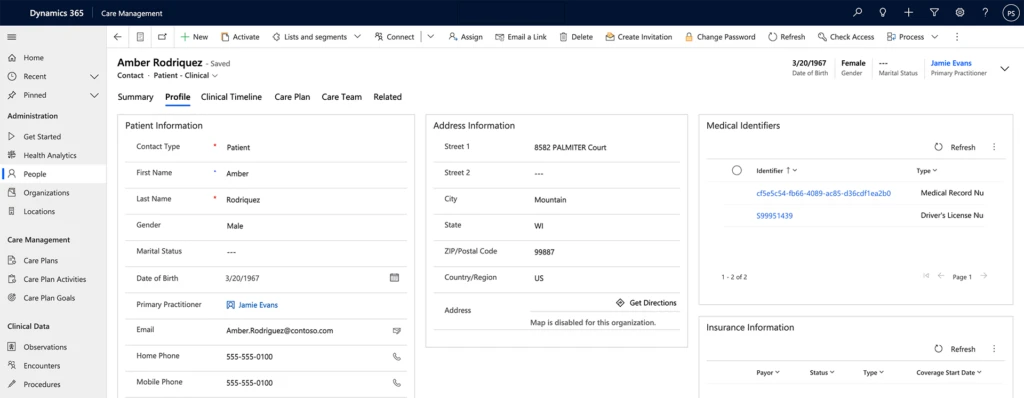
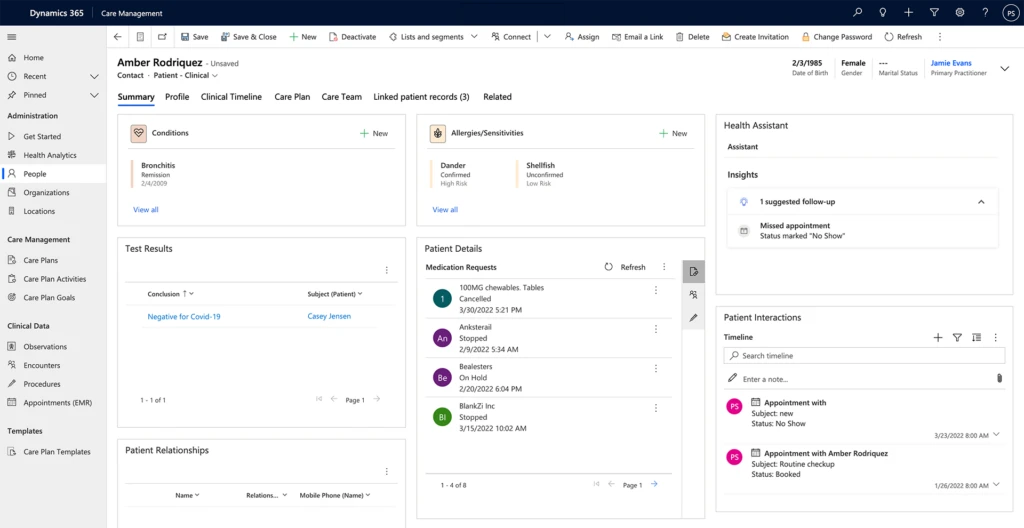
Solving the common issue of fragmented and multiple records for a single patient, we now offer better support for Fast Healthcare Interoperability Resources (FHIR) record merge capabilities. The new, generally available patient links enables the ability to view “rolled-up” patient data. Administrators and patient data specialists can now maintain Health Level Seven (HL7) FHIR® patient links (merge patients).
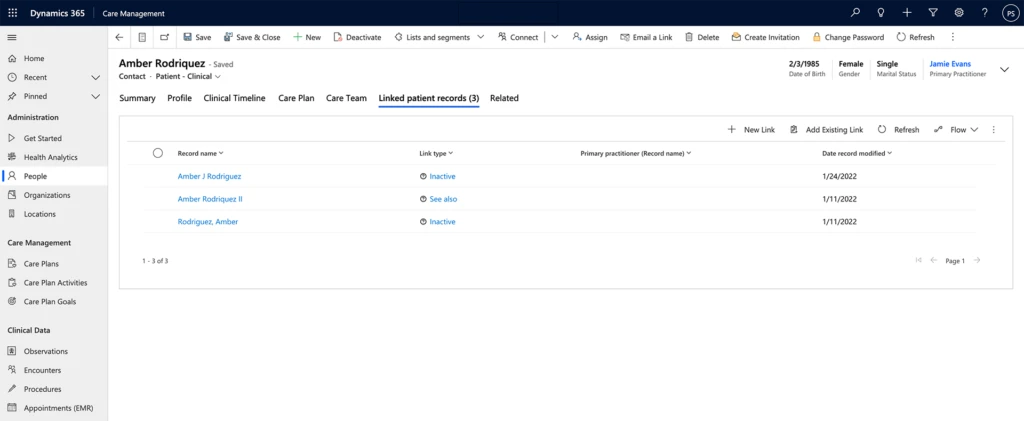
We are making it easy for clinicians to cut through the clutter of fragmented systems so they can focus on providing the best possible care using data from a variety of sources. Virtual Visit for Teams integration into Cerner Electric Health Records (EHR), now generally available, allows clinicians to easily launch a virtual patient visit directly from Cerner EHR. Embedded in the solution includes capabilities such as the ability to track if SMS notifications have been sent to the patient or to copy and re-send visit links.

Bringing data together
The volume of data produced by the healthcare industry from disparate sources including legacy systems is often large, unstructured, and not universally accessible. How healthcare organizations capture, store, interact, and leverage data is critical for clinical and operational effectiveness—both to enable insights and experiences. As such, data is at the very core of Microsoft Cloud for Healthcare. To help healthcare organizations improve insights, regardless of where the data resides, Microsoft Cloud for Healthcare helps customers structure their data with the healthcare data model and the Azure Health data services.
Our newly released Azure Health Data Services is technology for Protected Health Information (PHI) in the cloud. It is also one of the only generally available solutions of its kind to ingest, manage, and transform a combination of clinical, imaging, and MedTech data formats into other data standards like Fast Healthcare Interoperability Resources (FHIR) and Digital Imaging and Communications in Medicine (DICOM). While other solutions exist for clinical and imaging data, Azure Health Data Services provides the most holistic view of the patient by unifying these three key types of health data. With Azure Health Data Services, you can bring together diverse datasets and streaming data from medical devices in the cloud.
Making sure data can be shared securely for research and AI development is what will bring about truly powerful change. Azure Health Data Services creates a strong cloud foundation for big data, which makes deep AI and machine learning possible. Azure Health Data Services can connect to Microsoft Power BI and Azure Synapse Analytics for visualizations and analytics, use SMART on FHIR apps to build new applications, and apply machine learning to create new algorithms for diagnosis assistance and research. As we look to the future, we also are building strong strategic partnerships with key health technology start-ups such as Truveta to integrate lifesaving and democratizing capabilities. Our recent acquisition of Nuance further brings AI, machine learning, and other leading-edge capabilities to Microsoft Cloud for Healthcare.
Optimize data footprints with real-time data routing
When utilizing data to support business processes, such as a patient service center, organizations often ingest data from multiple systems. No single system hosts all the data—and controlling how much data is duplicated between systems is a priority to ensure efficient technology architecture. Today we are announcing the release of virtual health data tables. This capability optimizes the cloud storage spend, allowing organizations to virtualize their clinical reference data when using model-driven applications. Health data can remain where it is, or it can be transferred to Microsoft Dataverse, which allows organizations to securely store and manage data that can easily be used by business applications. This new feature takes advantage of Dataverse virtual tables combined with a health data routing concept, allowing dynamic switching of the underlying data source between native Dataverse storage and direct access to external Azure Health Data Services for select healthcare tables. For more details, read our FAQ.

Dataverse Health Data Exchange API, upcoming preview in May, is a new data interoperability method that allows organizations to move data between cloud for healthcare solutions and health information systems, that expose data as FHIR Bundles. These features work in environments with or without FHIR server implementations. With the Dataverse Health Data Exchange API, organizations get full control of the integration architecture, rules, and logic.
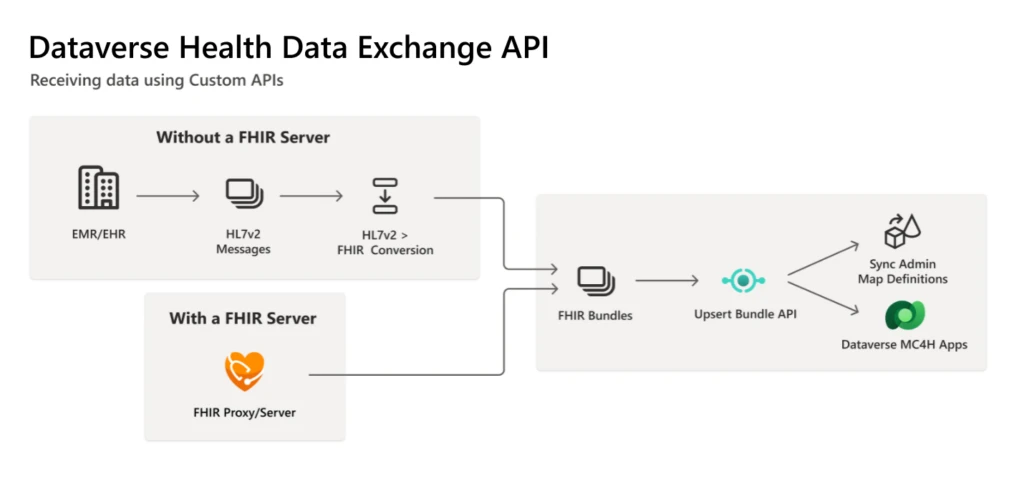
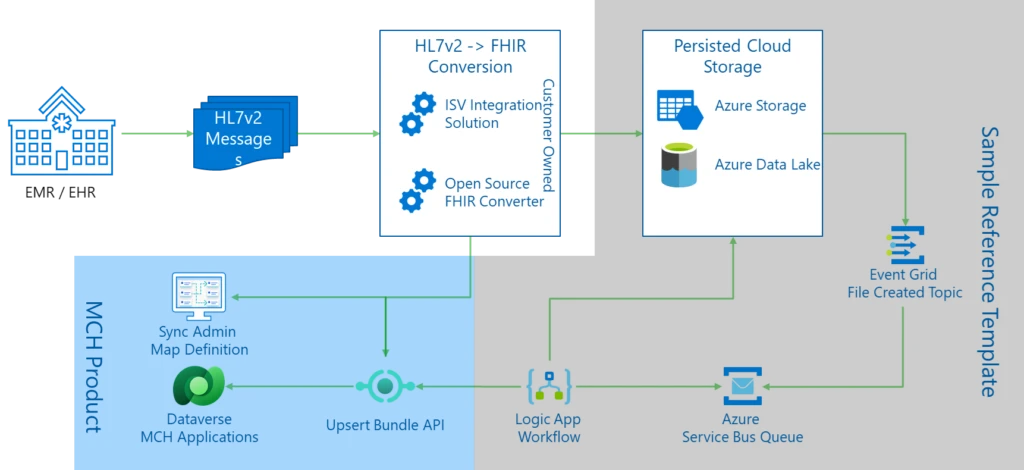
Work intuitively with natural language processing
Organizations can further leverage analytics through natural language processing to improve the delivery of clinical insights with our preview release of Text Analytics free text to FHIR feature. This enables healthcare organizations to find and label valuable information in unstructured clinical documents, transforming them into bundles of interconnected, hierarchical FHIR resources that adhere to core FHIR guidelines.
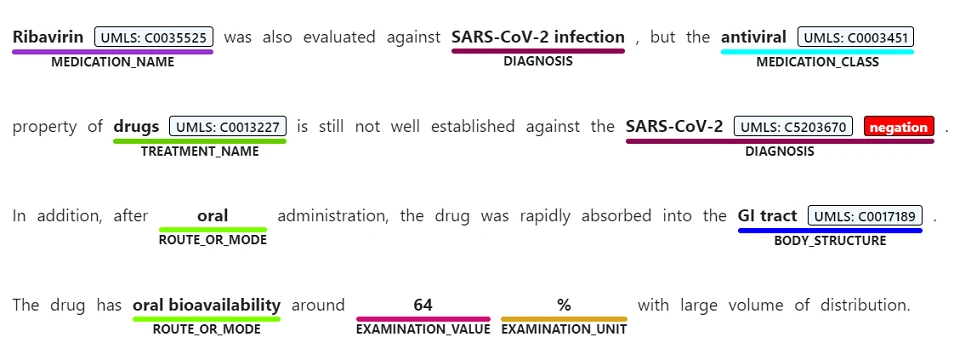
Empower your healthcare team with collaborative tools
Care managers often manage hundreds of patients with limited time; they need clear visibility into planned activities and tasks to better organize their day. The need for timely touchpoints with patients to support care plan adherence is part of our collaboration focus. We are delivering a more focused workplace for care coordinators to help organize their appointments and follow-ups with intuitive charts to understand progress, upcoming activities, and immediate next actions. We are releasing a new Care Plan Activities Dashboard, in preview, that provides care coordinator and care management views with filtering capabilities.

As part of our investment to help onboard new team members quickly and keep the whole workforce aligned, we are releasing guided tours. This feature is immediately available in the Care Management solution and will be available in other solutions in future updates. Organizations can onboard new users and highlight new features with ease—including in-app guides that describe frequently used features and scenarios. Users can continue to interact with the solution in the background as they are guided through the product. The homepage also provides how-to guides and resources to help the care coordination teams make the most of the care management solution and increase job satisfaction.
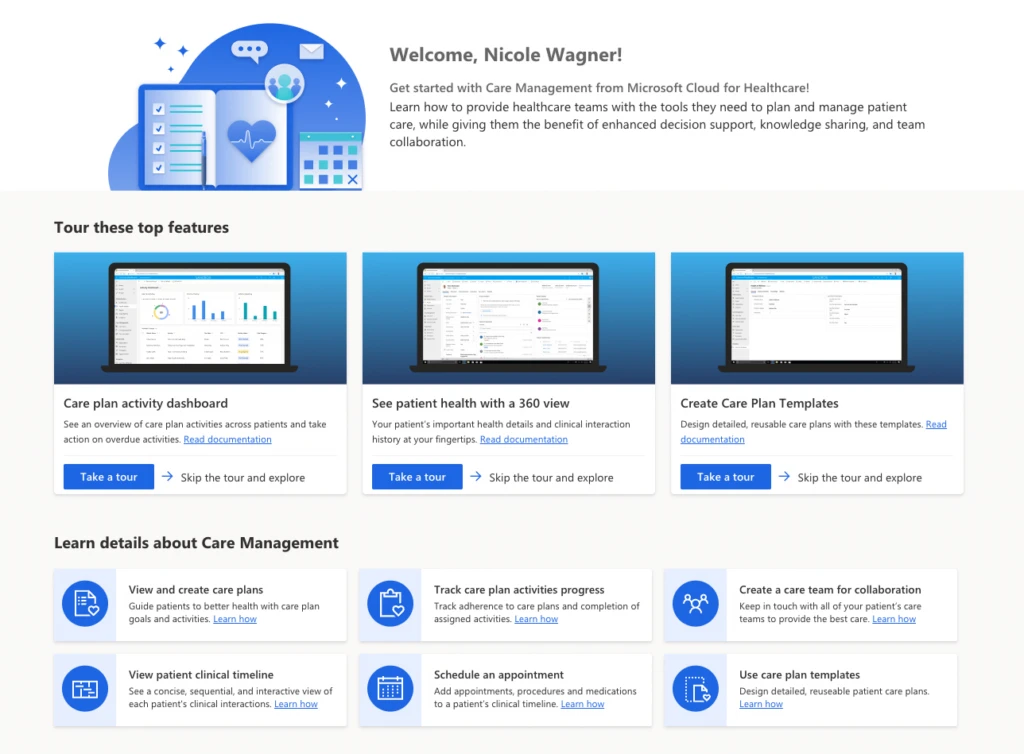
We enable organizations to build and deploy AI-powered, compliant, and white-labeled experiences at scale. Last month we announced new templates for Azure Health Bot, our intelligent and industry-relevant conversational service, to quickly build custom scenarios for popular healthcare use cases—saving teams valuable time and ensuring consistent quality of care. Azure Health Bot allows healthcare organizations to instantly build bot scenarios for collecting secure and compliant responses directly from patients for use cases like triage, flu vaccinations, and more. This release expands the catalog with new templates for self-reporting of quality-of-life measures and chronic condition management.
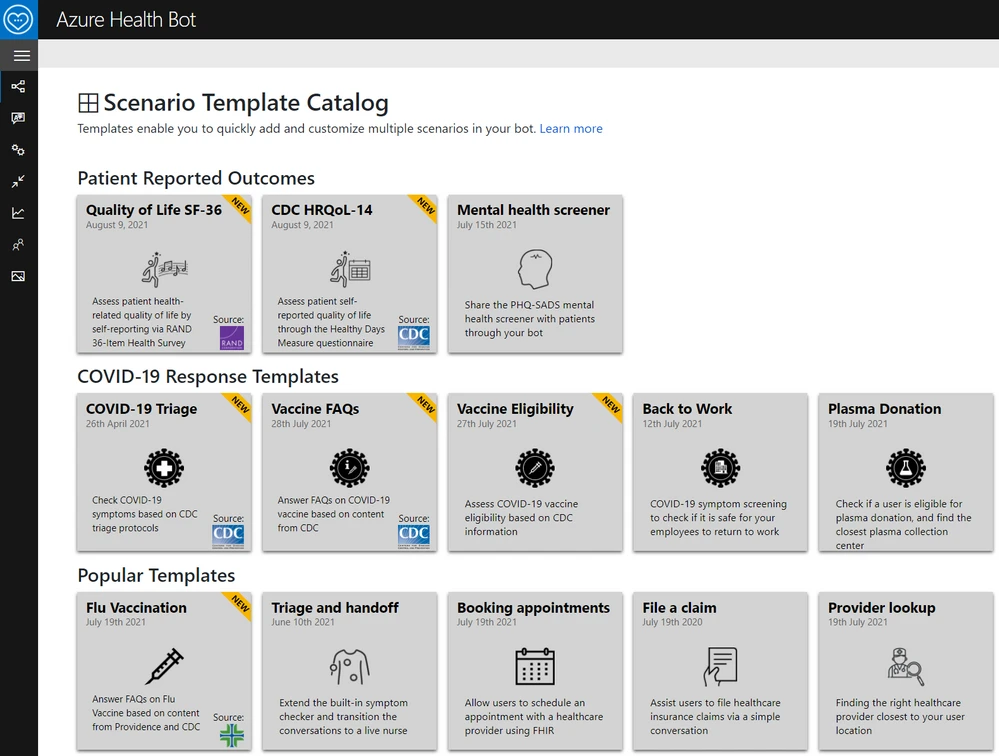
Healthcare organizations can accelerate their business processes by automating information extraction; applying AI and machine learning frameworks that utilize analytics data to assist in many different processes. With Azure Forms Recognizer, patients can take photos of their identifications and insurance cards and submit them before arriving at their appointments, reducing data capture errors and manual effort. Learn how customers like HCA Healthcare are using Azure Forms Recognizer to cut down on administrative time spent entering repetitive card data into their care system
Where we’re headed: A global commitment
Microsoft is committed to supporting customers around the globe. Microsoft Cloud for Healthcare previously available in eight countries is expanding our offering to include another nine countries—Switzerland, Brazil, Sweden, Denmark, Finland, Belgium, Ireland, New Zealand, and the Philippines. Further, as part of our commitment to providing a complete product experience, healthcare solutions are now available in ten languages: English, French, Dutch, German, Danish, Italian, Swedish, Finnish, Spanish, and Brazilian Portuguese.
Microsoft Cloud for Healthcare is continually expanding its ability to provide a unified approach that enables healthcare organizations to compete and grow through greater efficiency and improved patient and workforce experiences—ultimately resulting in delivery of care faster, better, and at a lower cost. We are excited about how this series of updates builds on our strong foundation, and for our continued future investment in healthcare. You can learn more about Microsoft Cloud for Healthcare by signing up to stay informed and following us on social.
FHIR® is the registered trademark of HL7 and is used with the permission of HL7.




